Safety and Stability Analysis of Demolition and Reconstruction of Existing Railway Bridge Piers and Caps
Abstract
Featured Application
Abstract
1. Introduction
2. Numerical Model
2.1. Finite Element Model
2.2. Model Validation
2.3. Selection of Working Conditions
3. Force Analysis of Steel Bracket
- (1)
- The middle-span steel columns directly bear the trainload transferred by the supporting longitudinal beam and cross-beam when the trainload operates on line I and line II, whereas the trainload acting on line IV has no direct effect on the middle-span steel columns, which only bear the self-weight generated by the superstructure, so the maximum stress of the middle-span steel columns under case 3 is 35% of that under case 1 and 2;
- (2)
- The diagonal braces are subjected to the greatest stress among the components in the three cases, whose maximum stress is less than the yield strength of Q235 steel [31], indicating that the entire steel bracket system is in an elastic stage under the trainload, which means that the bracket design can meet the safety requirements.
4. Displacement and Stress of Bridge and Track Components
5. Technical Solutions for On-Site Construction
5.1. Railroad Bridge Bearing In Situ Bracket Replacement Technology
5.1.1. Construction of Steel Pipe Pile
5.1.2. Construction of Temporary Steel Bracket
5.1.3. Replacement Construction of the Bridge-Bearing Bracket
5.1.4. Demolition of Old Bridge Piers and Bearings
5.1.5. Newly Constructed Piers and Abutments
5.2. Problems and Solutions of In Situ Replacement Construction
5.2.1. Narrow Operating Space
5.2.2. Construction of Steel Pipe Piles Encountering Underground Obstacles
5.2.3. Negative Impact on Other Structural Members
6. Conclusions
- (1)
- The stress and deformation of the main components of the steel bracket system meet the design requirements in each load condition, which means the safety and stability of the structure can be guaranteed;
- (2)
- For the stress and displacement distribution of the steel pipe pile under the trainload, the maximum stress appears at the bottom of the pile, while the maximum displacement appears at the top of the pile, and the magnitude of stress and displacement of the steel pipe pile decreases from the area of the trainload to both sides;
- (3)
- The greater the distance between the two intersection points of the longitudinal beam and its supporting crossbeams below, the larger the deflection of the longitudinal beam above it;
- (4)
- Due to the presence of the middle-span steel column, the overall stiffness of the supporting structure under line I and line II is higher than that under line IV;
- (5)
- The railway bridge-bearing in situ replacement construction plan has little impact on the existing railway bridge girders, and the steel bracket is simple in force form, but there are also corresponding problems in the process of construction operations that must be addressed by applying various safeguard measures to maximize the superiority of this construction plan.
Author Contributions
Funding
Institutional Review Board Statement
Informed Consent Statement
Data Availability Statement
Conflicts of Interest
References
- Cook, W.; Paul, J.B.; Marvin, W.H. Bridge failure rate. J. Perform. Constr. Facil. 2013, 29, 04014080. [Google Scholar] [CrossRef]
- Mitoulis, S.A.; Argyroudis, S.A.; Loli, M.; Imam, B. Restoration models for quantifying flood resilience of bridges. Eng. Struct. 2021, 238, 112180. [Google Scholar] [CrossRef]
- Pejović, J.; Serdar, N.; Pejović, R. Damage assessment of road bridges caused by extreme streamflow in Montenegro: Reconstruction and structural upgrading. Buildings 2022, 12, 810. [Google Scholar] [CrossRef]
- Yuan, Z.W. Study on reconstruction technology for river-crossing multi-span bridge on railway operating line. Railw. Constr. Technol. 2019, 5, 56–59+89. (In Chinese) [Google Scholar]
- Wang, J. Application of bridge demolition technique in reconstruction and expansion engineering of expressway. Transp. Res. 2014, 42, 156–159. (In Chinese) [Google Scholar] [CrossRef]
- Deng, D.Y.; Zhang, X.Q.; Chen, Z.; Yang, G.F.; Lu, J.X. Study on force of steel bracket for construction of large span and wide steel box girder. IOP Conf. Ser. Mat. Sci. Eng. 2019, 490, 032013. [Google Scholar] [CrossRef]
- Horyl, P.; Šňupárek, R. Behaviour of steel arch supports under dynamic effects of rockbursts. Min. Technol. 2007, 116, 119–128. [Google Scholar] [CrossRef]
- Bobet, A.; Yu, H.T. Full stress and displacement fields for steel-lined deep pressure tunnels in transversely anisotropic rock. Tunn. Undergr. Space Technol. 2016, 56, 125–135. [Google Scholar] [CrossRef]
- Rodríguez, R.; Díaz-Aguado, M.B. Deduction and use of an analytical expression for the characteristic curve of a support based on yielding steel ribs. Tunn. Undergr. Space Technol. 2013, 33, 159–170. [Google Scholar] [CrossRef]
- Khalymendyk, I.; Baryshnikov, A. The mechanism of roadway deformation in conditions of laminated rocks. J. Sustain. Min. 2018, 17, 41–47. [Google Scholar] [CrossRef]
- Rotkegel, M.; Bock, S. Impact of bearing plates dimensions on interaction of mine workings support and rock mass. J. Sustain. Min. 2015, 14, 12–20. [Google Scholar] [CrossRef]
- Zang, D.S.; Li, A.Q. Study on concrete-filled steel tube supports. Chin. J. Geotech. Eng. 2001, 23, 342–344. (In Chinese) [Google Scholar]
- Zang, D.S.; Wei, L. Research and lab test of steel tube concrete support. Mine Constr. Technol. 2001, 6, 25–28. (In Chinese) [Google Scholar]
- Huang, W.P.; Yuan, Q.; Tan, Y.L.; Wang, J.; Liu, G.L.; Qu, G.L.; Li, C. An innovative support technology employing a concrete-filled steel tubular structure for a 1000-m-deep roadway in a high in situ stress field. Tunn. Undergr. Space Technol. 2018, 73, 26–36. [Google Scholar] [CrossRef]
- Zhang, J.P.; Liu, L.M.; Cao, J.Z.; Yan, X.; Zhang, F.T. Mechanism and application of concrete-filled steel tubular support in deep and high stress roadway. Constr. Build. Mater. 2018, 186, 233–246. [Google Scholar] [CrossRef]
- Fu, M.Z.; Liang, Y.X.; Feng, Q.S.; Wu, B.T.; Tang, G.X. Research on the application of multi-source data analysis for bridge safety monitoring in the reconstruction and demolition process. Buildings 2022, 12, 1195. [Google Scholar] [CrossRef]
- Han, X.; Yang, D.Y.; Frangopol, D.M. Optimum maintenance of deteriorated steel bridges using corrosion resistant steel based on system reliability and life-cycle cost. Eng. Struct. 2021, 243, 112633. [Google Scholar] [CrossRef]
- Seyed, K.A.; Akbari, R.; Maalek, S.; Gharighoran, A. Assessment of design and retrofitting solutions on the progressive collapse of Hongqi Bridge. Shock Vib. 2020, 2020, 4932721. [Google Scholar] [CrossRef]
- Tazarv, M.; Sjurseth, T.; Greeneway, E.; Hart, K.; LaVoy, M.; Wehbe, N. Experimental studies on seismic performance of mechanically spliced precast bridge columns. J. Bridge Eng. 2022, 27, 0001948. [Google Scholar] [CrossRef]
- Mansouri, S.; Kontoni, D.P.N.; Pouraminian, M. The effects of the duration, intensity and magnitude of far-fault earthquakes on the seismic response of RC bridges retrofitted with seismic bearings. Adv. Bridge Eng. 2022, 3, 19. [Google Scholar] [CrossRef]
- Huang, Q.; Wu, X.G.; Zhang, Y.F.; Ma, M. Proposed new analytical method of tower load in large-span arch bridge cable lifting construction. Appl. Sci. 2022, 12, 9373. [Google Scholar] [CrossRef]
- Li, Q.F.; Zhang, T.J. Research on the reliability of bridge structure construction process system based on copula theory. Appl. Sci. 2022, 12, 8137. [Google Scholar] [CrossRef]
- Tan, S.Y. Study on Vibration Transfer Characteristics and Structure Selection of Railway Track in Active Fault Zone Tunnels. Master’s Thesis, Beijing Jiaotong University, Beijing, China, 2017. (In Chinese). [Google Scholar]
- Qi, W.; Cao, Y.; Zhao, Z.H.; Mo, H.Y. Research on the influence of track gauge on stress characteristics of track structure. Railw. Eng. 2020, 60, 131–134. (In Chinese) [Google Scholar]
- Galvín, P.; François, S.; Schevenels, M.; Bongini, E.; Degrande, G.; Lombaert, G. A 2.5D coupled FE-BE model for the prediction of railway induced vibrations. Soil Dyn. Earthq. Eng. 2010, 30, 1500–1512. [Google Scholar] [CrossRef]
- Costa, P.A.; Calçada, R.; Cardoso, A.S. Ballast mats for the reduction of railway traffic vibrations. Numerical study. Soil Dyn. Earthq. Eng. 2012, 42, 137–150. [Google Scholar] [CrossRef]
- Cai, X.P.; Tan, S.Y.; Shen, Y.P.; Cai, X.H. Dynamic analysis of laying elastic sleeper on ballast track in tunnel. J. China Railw. Soc. 2018, 40, 87–93. (In Chinese) [Google Scholar]
- Pan, L.; Xu, L.; Chen, X.M.; Zhu, Z.X. Curved ballasted track-vehicle dynamic interaction: Effects of curve radius and track structural nonlinearity. J. Comput. Nonlinear Dynam. 2021, 16, 071004. [Google Scholar] [CrossRef]
- Lee, J.; Oh, K.; Park, Y.; Choi, J. Study on the applicability of dynamic factor standards by comparison of spring constant based dynamic factor of ballasted and concrete track structures. Appl. Sci. 2020, 10, 8361. [Google Scholar] [CrossRef]
- Cai, X.P.; Zhong, Y.L.; Hao, X.C.; Zhang, Y.R.; Cui, R.X. Dynamic behavior of a polyurethane foam solidified ballasted track in a heavy haul railway tunnel. Adv. Struct. Eng. 2019, 22, 751–764. [Google Scholar] [CrossRef]
- Ministry of Housing and Urban-Rural Development of the People’s Republic of China. Standard for Design of Steel Structures, 1st ed.; China Architecture & Building Press: Beijing, China, 2018. (In Chinese)

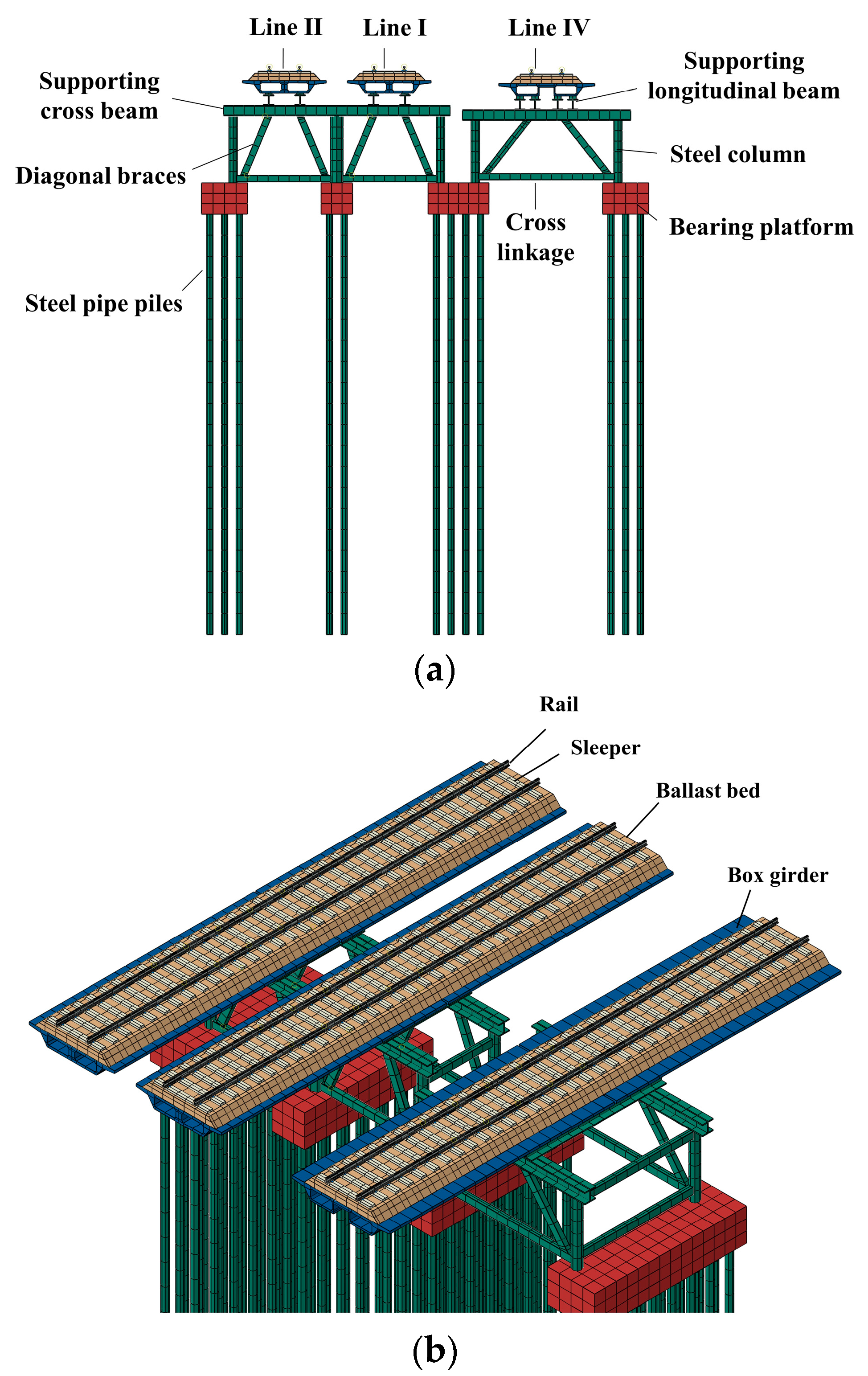

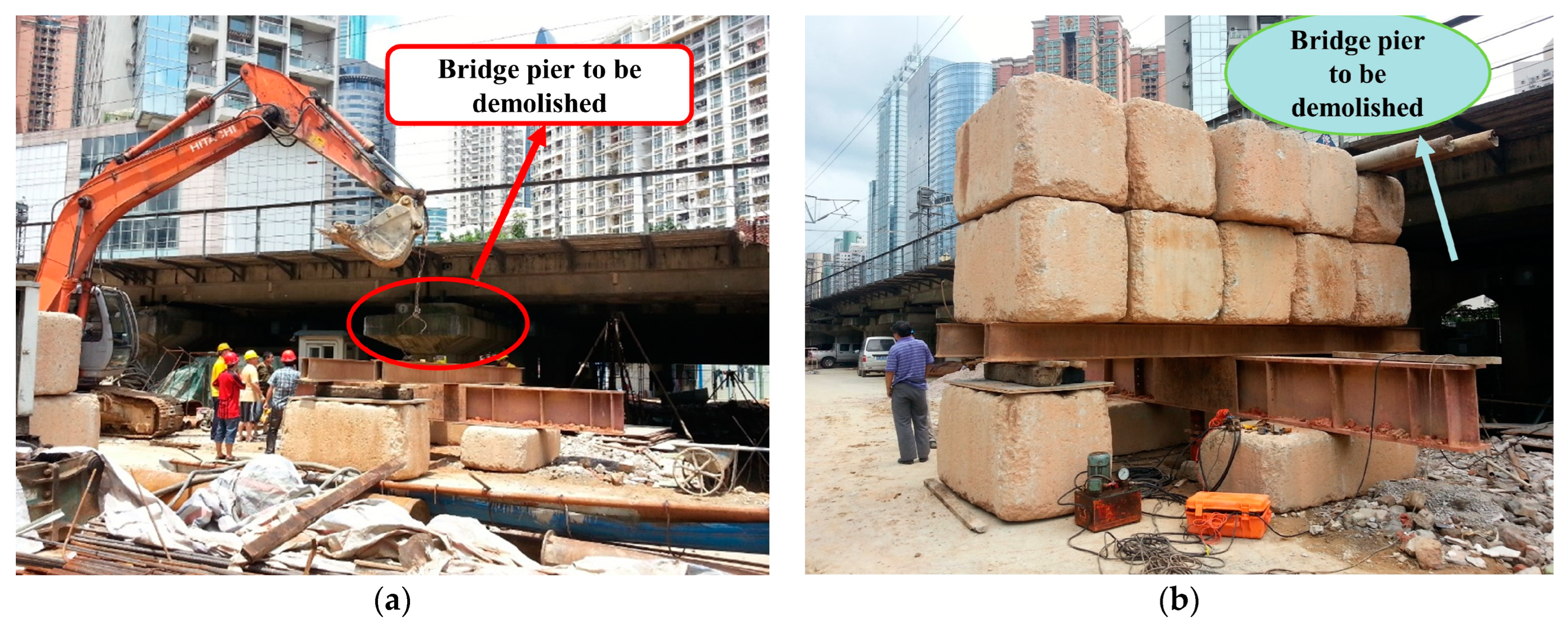
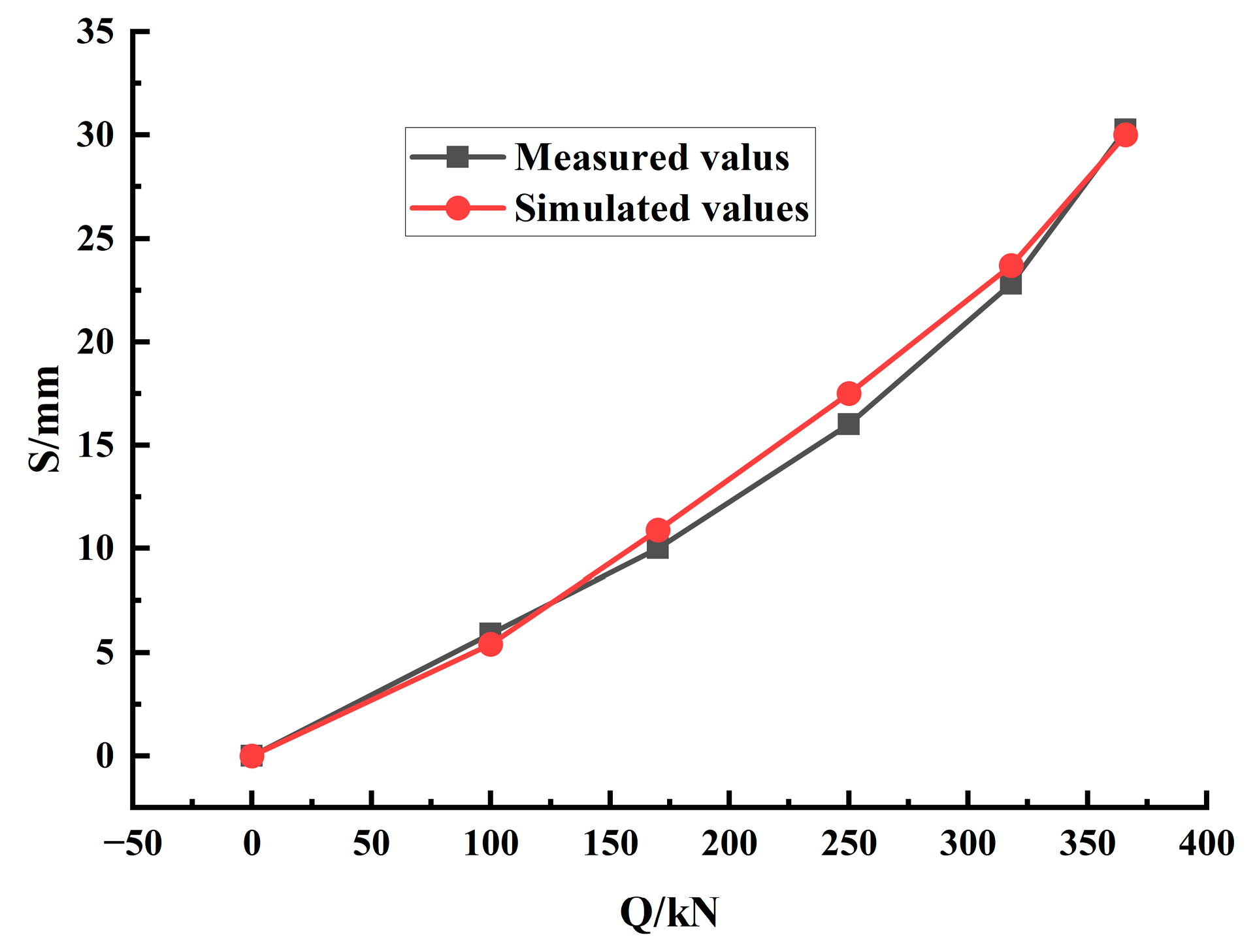


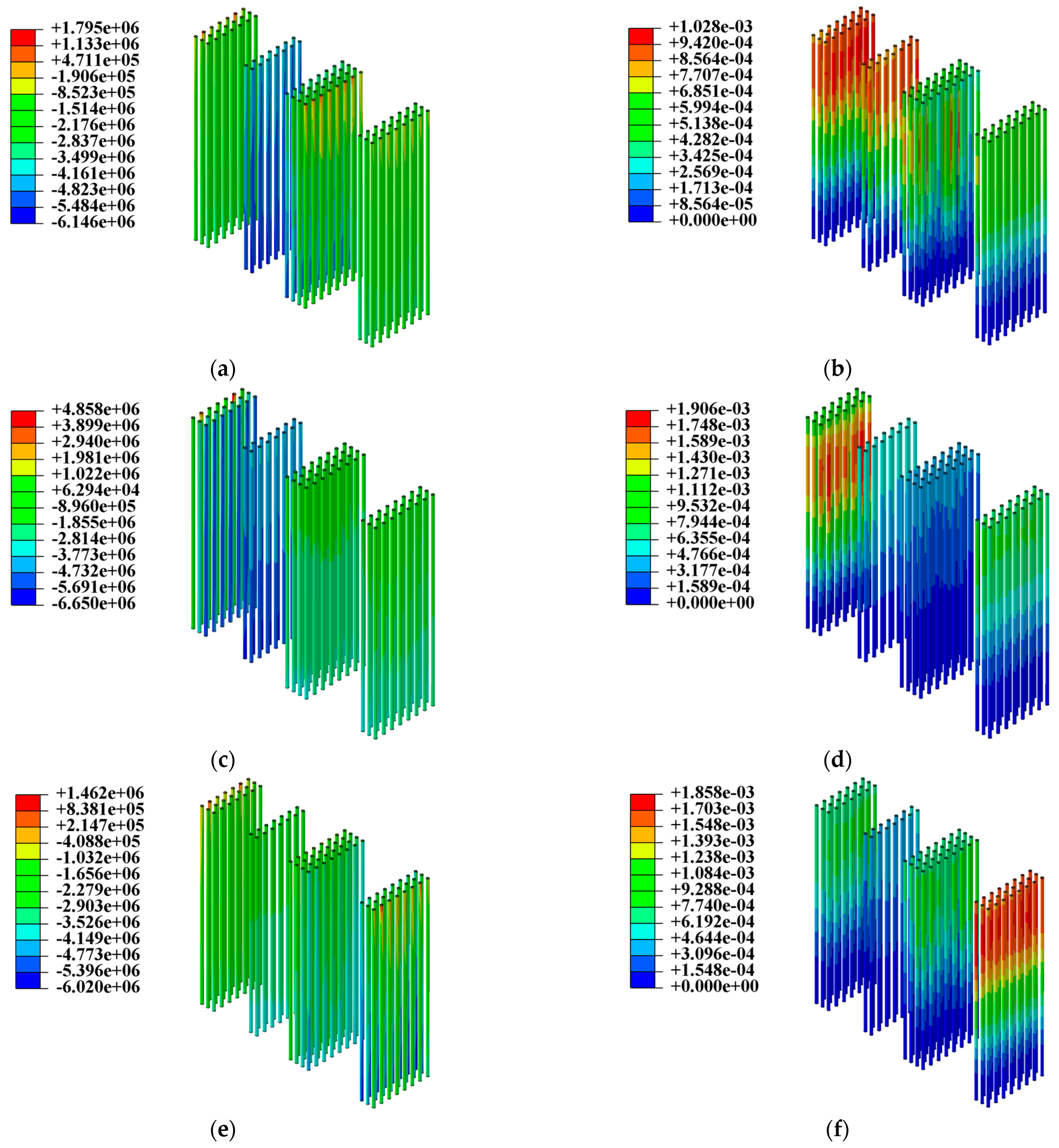
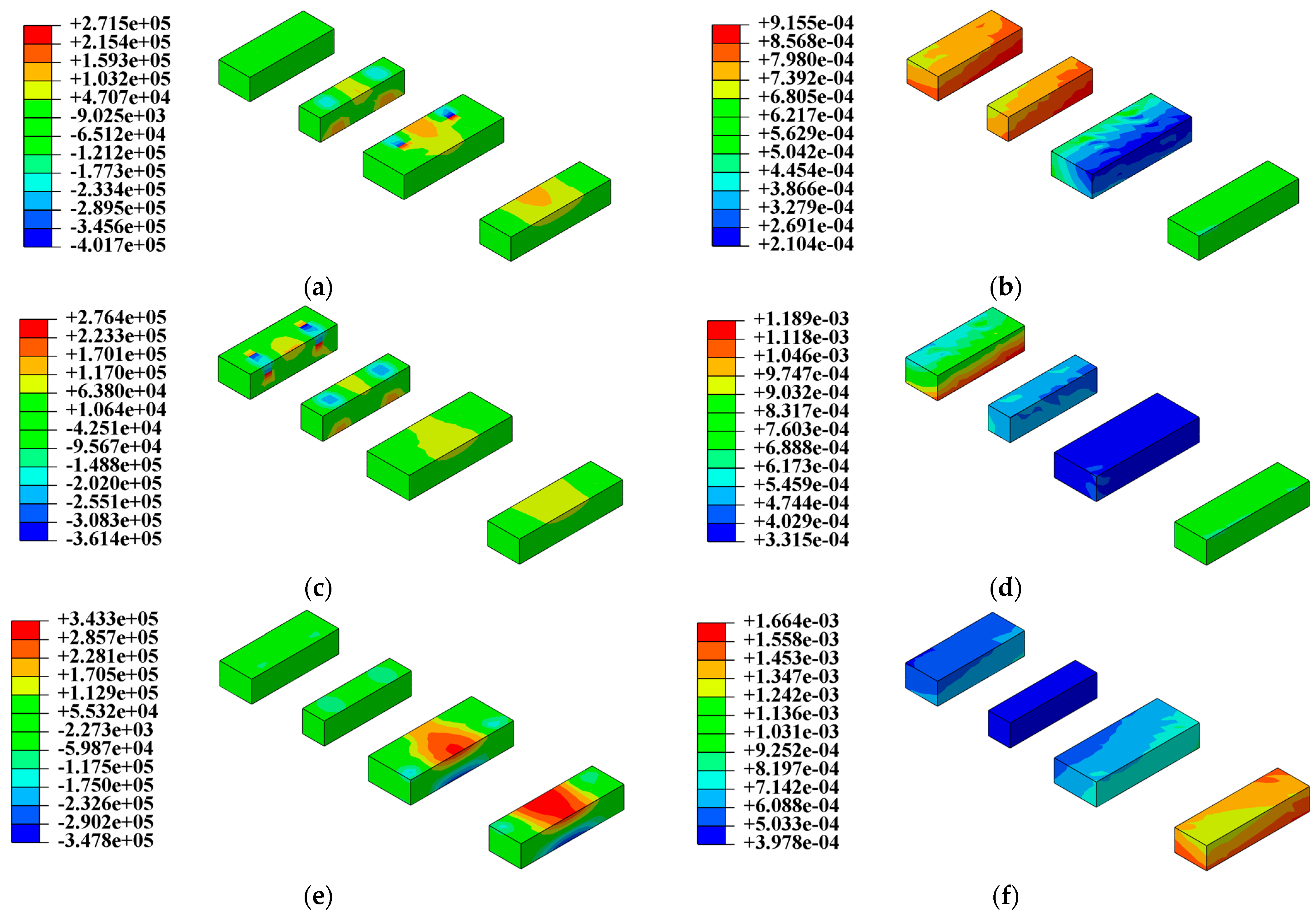

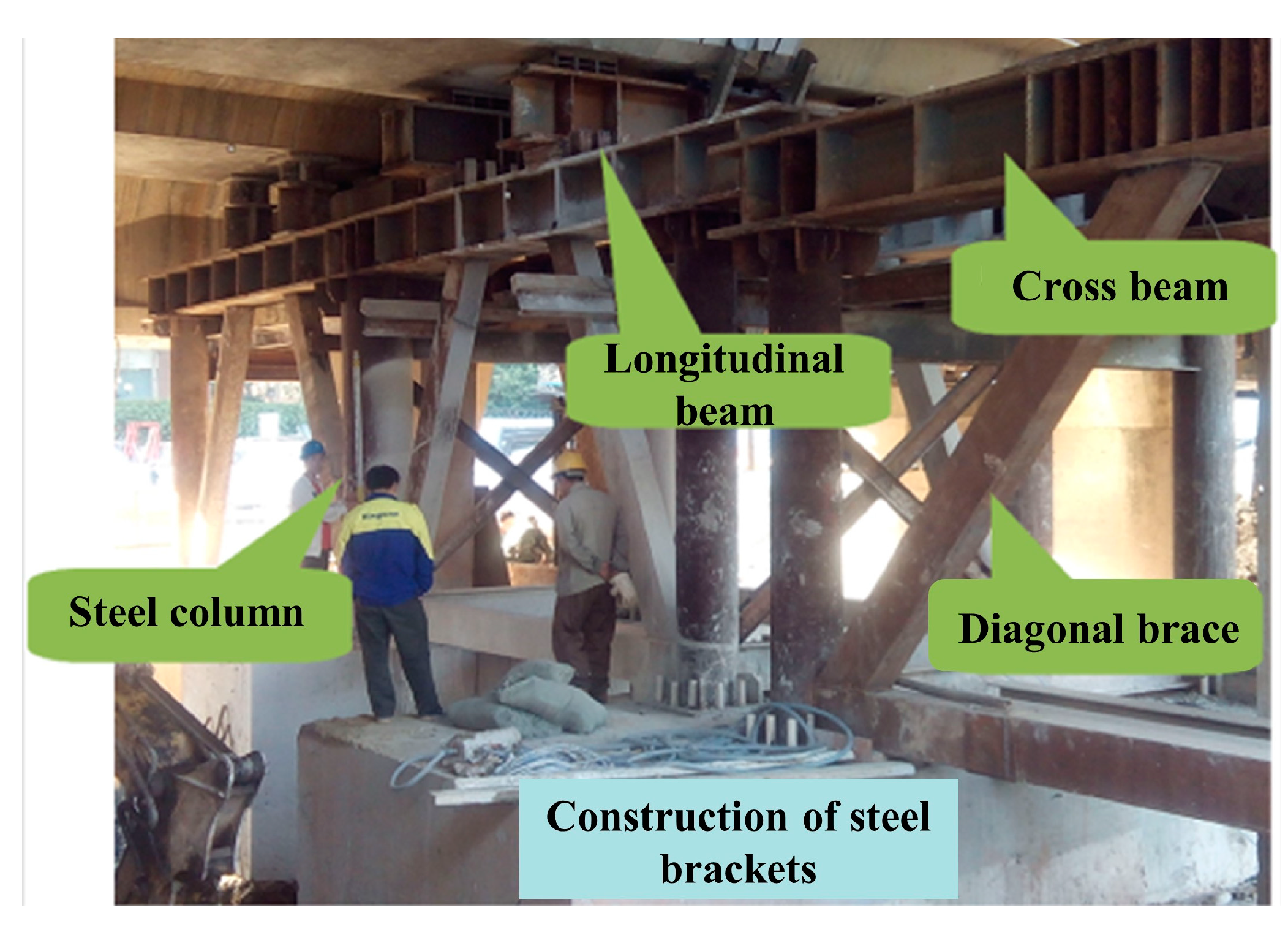
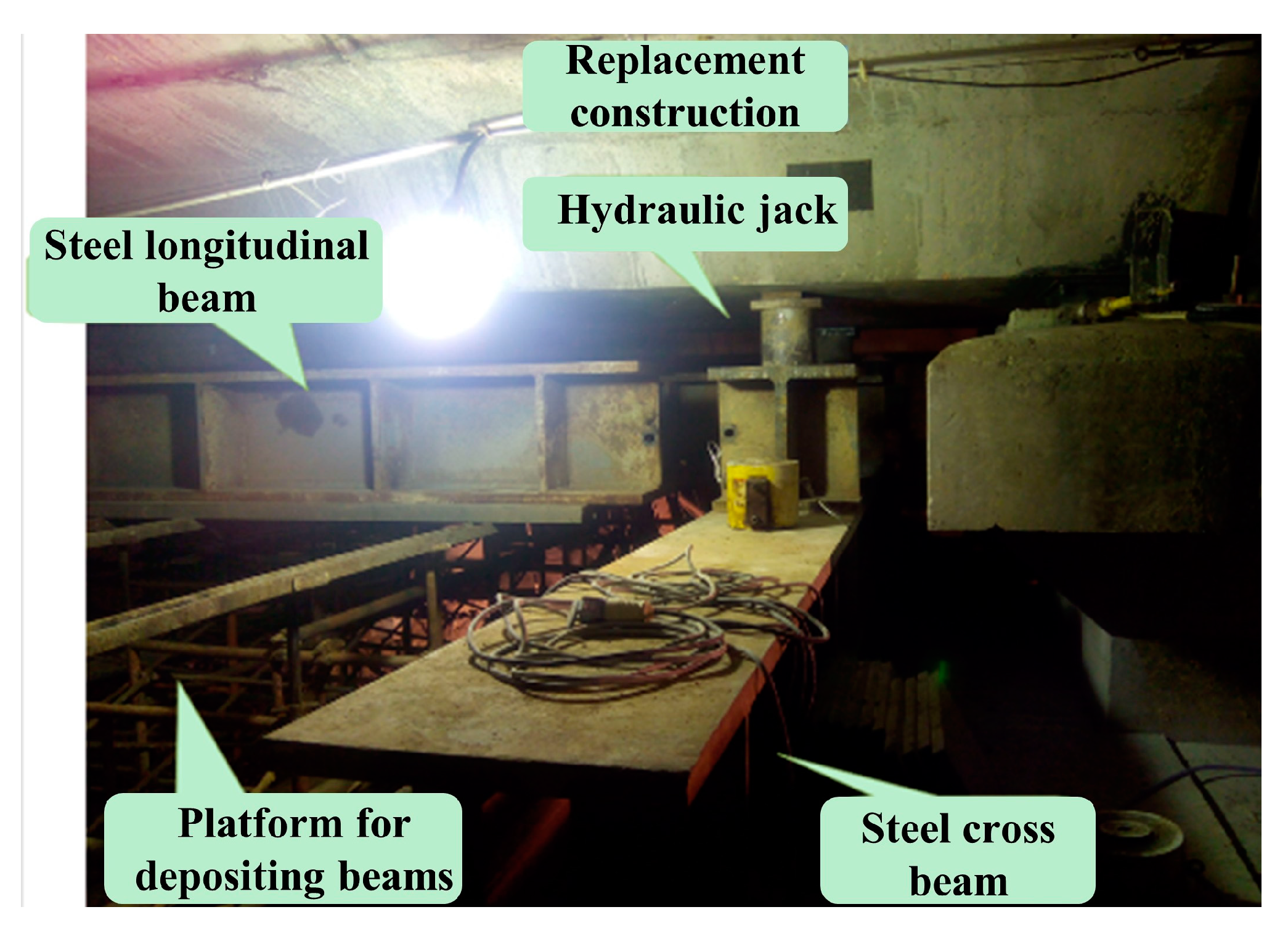
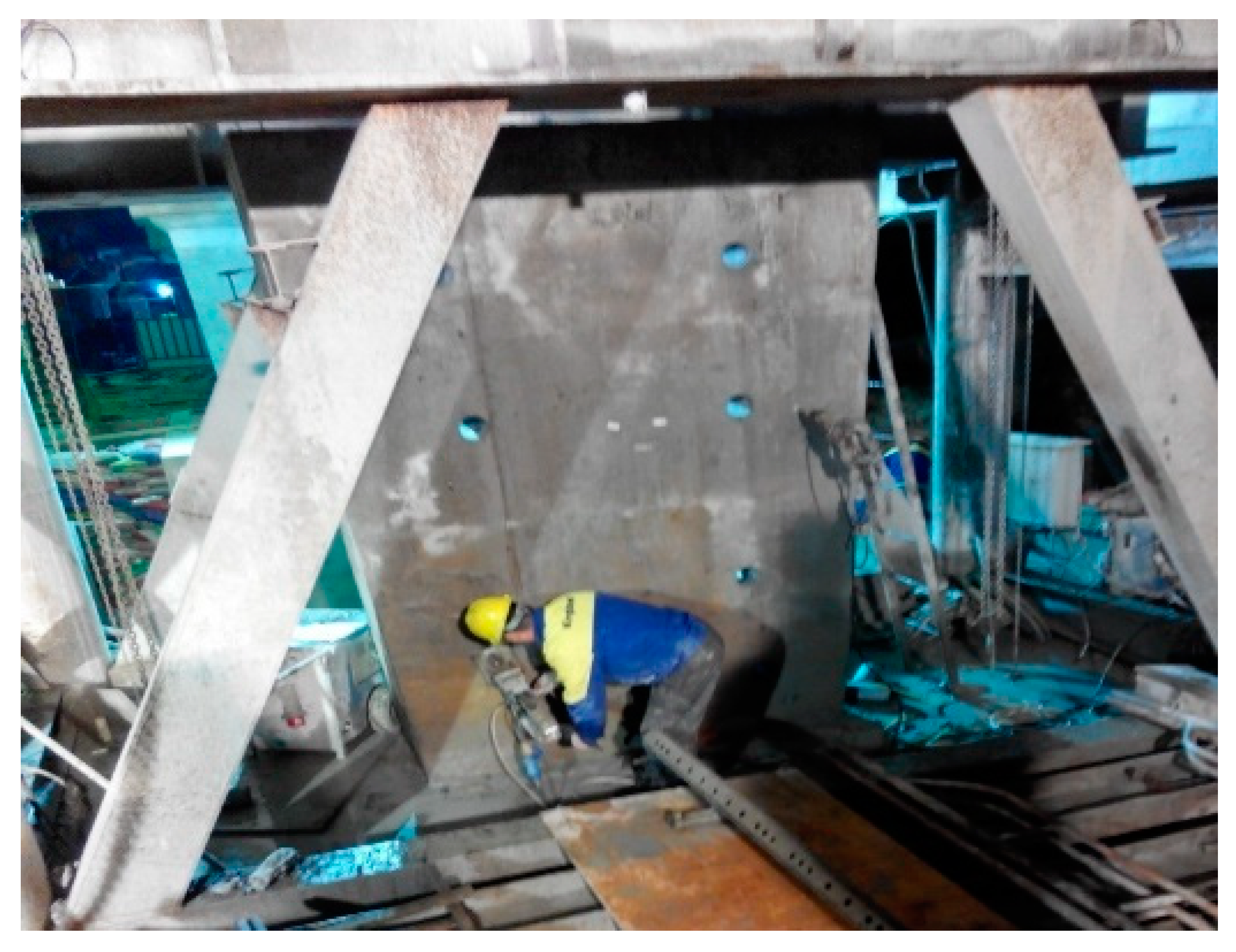

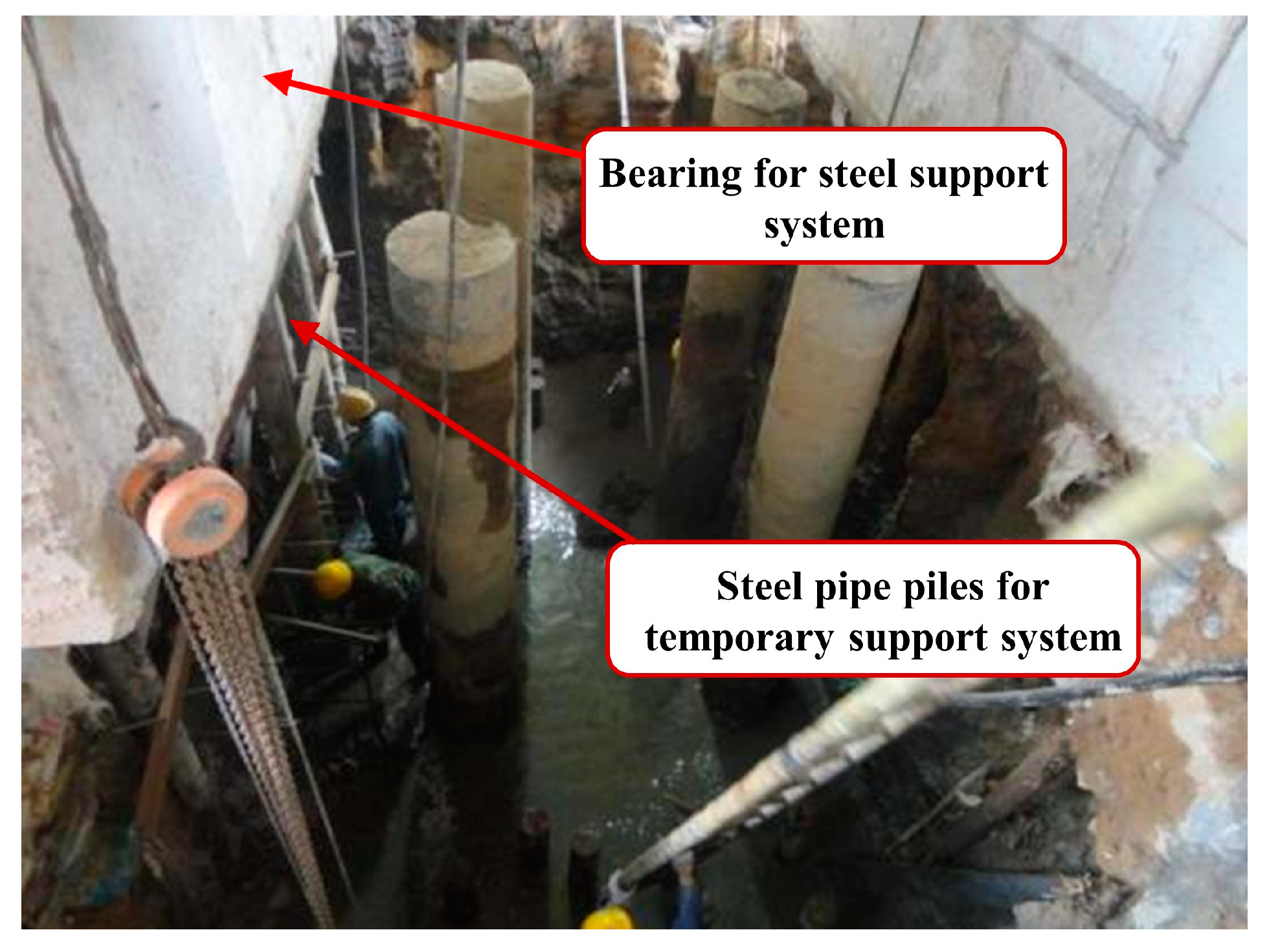

| Components | Elastic Modulus (MPa) | Density (kg·m−3) | Poisson’s Ratio |
|---|---|---|---|
| Rail | 210,000 | 7800 | 0.3 |
| Sleeper | 36,500 | 2500 | 0.2 |
| Ballast bed | 130 | 1800 | 0.3 |
| Box girder | 34,500 | 2500 | 0.2 |
| Supporting rods | 210,000 | 7800 | 0.3 |
| Bearing | 30,000 | 2360 | 0.2 |
| Soil Layers | Thickness of Layers (m) | Young Modulus (MPa) | Poisson’s Ration | Density (kg·m−3) | Cohesion (kPa) | Angle of Internal Friction (°) |
|---|---|---|---|---|---|---|
| Sand | 0.9 | 22 | 0.38 | 1520 | 40 | 21 |
| Silt | 3.875 | 24 | 0.36 | 1520 | 42 | 26 |
| Siltstone | 7.875 | 26 | 0.34 | 1560 | 36 | 31 |
| Silty clay | 7.35 | 26 | 0.35 | 1560 | 45 | 35 |
| Working Condition | |||
|---|---|---|---|
| 1 | |||
| 2 | |||
| 3 | |||
| 4 |
| Components | Maximum Stress (MPa) | ||
|---|---|---|---|
| Case 1 | Case 2 | Case 3 | |
| Supporting longitudinal beam | 73.62 | 73.82 | 68.69 |
| Supporting cross beam | 29.09 | 18.71 | 29.79 |
| Diagonal brace | 81.97 | 89.35 | 88.01 |
| Cross linkage | 78.92 | 80.33 | 85.60 |
| Longitudinal linkage | 30.01 | 35.53 | 30.38 |
| Side-span steel column | 23.48 | 20.34 | 15.33 |
| Middle-span steel column | 8.99 | 9.05 | 3.18 |
| Maximum Deflection (mm) | Case 1 | Case 2 | Case 3 |
|---|---|---|---|
| Longitudinal beam | 1.03 | 1.17 | 2.13 |
| Cross beam | 0.97 | 0.97 | 2.05 |
| Indicators | Displacement (mm) | Tensile Stress (MPa) | Compressive Stress (MPa) | ||||
|---|---|---|---|---|---|---|---|
| Rails | Sleepers | Ballast Bed | Box Girder | Rails | Rails | Ballast Bed | |
| Condition 1 | 4.273 | 4.445 | 4.434 | 4.404 | 38.27 | 45.34 | 0.121 |
| Condition 2 | 4.297 | 4.653 | 4.637 | 4.642 | 38.29 | 45.30 | 0.123 |
| Condition 3 | 7.057 | 7.233 | 7.225 | 7.343 | 39.18 | 45.41 | 0.177 |
Disclaimer/Publisher’s Note: The statements, opinions and data contained in all publications are solely those of the individual author(s) and contributor(s) and not of MDPI and/or the editor(s). MDPI and/or the editor(s) disclaim responsibility for any injury to people or property resulting from any ideas, methods, instructions or products referred to in the content. |
© 2023 by the authors. Licensee MDPI, Basel, Switzerland. This article is an open access article distributed under the terms and conditions of the Creative Commons Attribution (CC BY) license (https://creativecommons.org/licenses/by/4.0/).
Share and Cite
Pan, P.; Chen, W.; Wu, P. Safety and Stability Analysis of Demolition and Reconstruction of Existing Railway Bridge Piers and Caps. Appl. Sci. 2023, 13, 7213. https://doi.org/10.3390/app13127213
Pan P, Chen W, Wu P. Safety and Stability Analysis of Demolition and Reconstruction of Existing Railway Bridge Piers and Caps. Applied Sciences. 2023; 13(12):7213. https://doi.org/10.3390/app13127213
Chicago/Turabian StylePan, Pengxu, Wei Chen, and Pei Wu. 2023. "Safety and Stability Analysis of Demolition and Reconstruction of Existing Railway Bridge Piers and Caps" Applied Sciences 13, no. 12: 7213. https://doi.org/10.3390/app13127213
APA StylePan, P., Chen, W., & Wu, P. (2023). Safety and Stability Analysis of Demolition and Reconstruction of Existing Railway Bridge Piers and Caps. Applied Sciences, 13(12), 7213. https://doi.org/10.3390/app13127213





